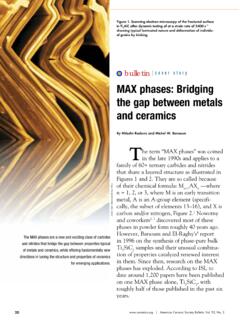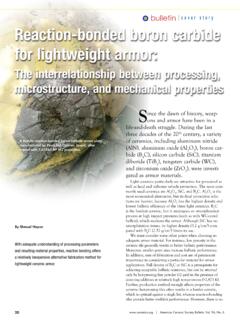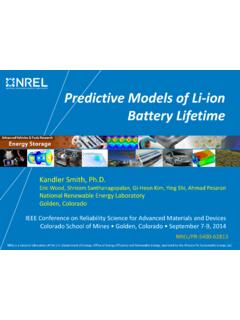Transcription of State of Solid-State Batteries - American Ceramic Society
1 State of Solid-State Batteries Prof. Kevin S. Jones Department of Materials Science and Engineering University of Florida Software and Analysis of Advanced Materials Processing Center Acknowledgments Dave Danielson Program Director at ARPA-E. Scott Faris, Richard Fox, Roland Pitts and Isaiah Oladeji at Planar Energy Software and Analysis of Advanced Materials Processing Center Outline Introduction Liquid vs. Solid-State Batteries Solid-State Li Ion Batteries Companies Battery Needs for Electric Vehicles BEEST Program Planar Energy Conclusions Software and Analysis of Advanced Materials Processing Center Typical Li Ion Battery During use (discharge). ions move from anode to cathode Figure courtesy C. Daniel JOM Vol. 60, pp. 43-48, 2008. Software and Analysis of Advanced Materials Processing Center Battery Basics Basic terminology Type I vs. Type II Battery: Type II (secondary) is rechargeable Li Metal vs. Li Ion Battery: Based on anode used; Li vs. a compound Capacity: Measure of Li that moves between the anode and cathode (Ah).
2 Cycle Life: Number of recharge cycles before x% of the capacity is lost Energy Density: Energy the battery can deliver per volume (Wh/l). Specific Energy: Energy the battery can deliver per mass (Wh/kg). Specific Power: A measure of the Watts the battery can deliver (W/kg). Software and Analysis of Advanced Materials Processing Center Existing Battery Types Ragone Plot Higher power and energy are driving the Li Ion battery growth Specific energy is the total energy a battery can deliver in watt-hours per kilogram (Wh/kg). Specific power is the battery's ability to deliver power in watts per kilogram (W/kg). Software and Analysis of Advanced Materials Processing Center Type II Battery Market 25000. 20000. Li Ion Li Polymer dominating the $10B. 15000 rechargeable $M. battery market Li Ion 10000. Li Ion sales 5000. forecast to more than NiMH. NiCd double in the 2000 2001 2002 2003 2004 2005 2006 2007 2008 2009 2010 2011 2012 2013 2014 2015 2016 2017 2018 2019 2020.
3 Next 10 years today Source: Software and Analysis of Advanced Materials Processing Center Why Li Ion Batteries ? Advantages High specific energy (Li is very light). High open circuit voltage (more power at low current). Less memory effect (observed in Ni Cd Batteries ). Slow self discharge (longer shelf life). Disadvantages Flammable liquids Limited Cell/cycle Life (SEI degradation). Battery life decreases with increasing temperature Software and Analysis of Advanced Materials Processing Center Outline Introduction Liquid vs. Solid-State Batteries Solid-State Li Ion Batteries Companies Battery Needs for Electric Vehicles BEEST Program Planar Energy Conclusions Software and Analysis of Advanced Materials Processing Center Types of Li Ion Batteries Liquid electrolyte LiPF6 in organic carbonates Li Ion conductivity 10-2-10-3S/cm Gel/polymer electrolyte Not covered in this talk Solid-State Ceramic electrolyte Focus of this talk Software and Analysis of Advanced Materials Processing Center Type II Battery Market 25000.
4 20000. Estimated Li Polymer current Solid-State 15000. battery $M. 10000. Li Ion sales <1%. of $8B Li 5000 Ion Battery NiMH. Market*. NiCd 2000 2001 2002 2003 2004 2005 2006 2007 2008 2009 2010 2011 2012 2013 2014 2015 2016 2017 2018 2019 2020. today Source: Software and Analysis of Advanced Materials Processing Center Why Solid-State Batteries ? Advantages over liquid Safety Would eliminate thermal runaway Performance Higher voltages possible Life Much longer cycle life Disadvantages Cost Traditionally very expensive to make Temperature sensitive Low temperature operation can be a challenge Software and Analysis of Advanced Materials Processing Center Liquid vs Solid-State Li Ion Battery Liquid solvent and polymer separator (not shown). Replaced by solid electrolyte Figure courtesy C. Daniel JOM Vol. 60, pp. 43-48, 2008. Software and Analysis of Advanced Materials Processing Center The most common Solid-State electrolyte LiPON. LiPON is a Solid-State electrolyte developed at Oak Ridge National Labs LiPON is an amorphous glass RF Magnetron deposition from Li3PO4 target in N2.
5 The chemical composition varies from to *. The N increases the Li ion conductivity relative to Li3PO4. Li Ion Conductivity of LiPON is ~2 x 10-6 S/cm still 3-4 orders of magnitude worse than liquid * Dudney, J. Power Sources, 89, 176, 2000. Software and Analysis of Advanced Materials Processing Center Conventional Solid-State Batteries Vacuum deposition for all layers Cathode: LiCoO2 or LiMn2O4 or V2O5. electrolyte : LiPON glass Anode: Li Metal or Sn3N4. Capacity: Typically very low ( to ). Normally LiPON. Source: Software and Analysis of Advanced Materials Processing Center Outline Introduction Liquid vs. Solid-State Batteries Solid-State Li Ion Batteries Companies Battery Needs for Electric Vehicles BEEST Program Planar Energy Conclusions Software and Analysis of Advanced Materials Processing Center Existing Solid-State Li Battery Companies Cymbet Excellatron Front Edge Infinite Power Sakti3. Seeo Toyota/AIST. Planar Energy Software and Analysis of Advanced Materials Processing Center Cymbet Enerchips Location: Minnesota Based Status: VC funded, selling product Product: Embedded battery back up on PC boards, microcontroller memory, SRAM etc.
6 electrolyte : LiPON. Capacity: Ah Batteries Additional features Very low self discharge rates (unlike liquid Batteries ). Source: Software and Analysis of Advanced Materials Processing Center Excellatron Location: Georgia Based Status: Private funded, Pilot Line Product: Thin film Batteries , Smart cards, RFID. implantable medical devices, IC's electrolyte : LiPON. Capacity: Batteries Additional features over 50,000 cycles for very thin ( m) cathodes (small capacity). Pulse discharge possible, 1000C rates Source: Software and Analysis of Advanced Materials Processing Center Front Edge Technology Location: California Based Status: VC funded, selling product Product: NanoEnergy ultra thin battery, smart card, portable sensors, and RFID tag. electrolyte : LiPON. Capacity: Ah Batteries Additional features: Thinnest Batteries (50 microns), Cycle Life >1000 at 100% discharge Flexible Source: NanoEnergy powering a blue LED. Software and Analysis of Advanced Materials Processing Center Infinite Power Solutions Location: Colorado Based Status: VC funded, Shipping product Product: World leader in Microbatteries (Micro energy cell).
7 Wireless sensor, active RFID, powered smart card, medical device, consumer electronic electrolyte : LiPON. Capacity: to Ah Additional features: Cycle life >10,000. Source: Software and Analysis of Advanced Materials Processing Center SAKTI3. Location: Michigan Based Status: VC funded, R&D. Product: Solid-State Batteries electrolyte : LiPON? Capacity: aimed at automotive market Additional features: Novel mechanical engineering of vacuum deposition process Not many technical details Source: Software and Analysis of Advanced Materials Processing Center SEEO Batteries Location: California Based Status: VC funded, R&D. Product: Solid-State Batteries electrolyte : solid Polymer Capacity: Goal: grid scale energy storage Additional features: electrolyte developed at LBL. Received DOE ARRA funding from Grid program Source: Software and Analysis of Advanced Materials Processing Center Toyota/AIST Solid-State Battery Location: Japan Status: Collaboration, R&D. Product: Solid-State Battery electrolyte : Li Oxide material (LIPON?)
8 Capacity: Additional features: Using Aerosol deposition (low temperature). electrolyte conductivity at 3-5 x 10-6 S/cm Source: _research/2010/20101224 Software and Analysis of Advanced Materials Processing Center Solid-State Battery Companies Company electrolyte Cathode Anode Size Status Cymbet LiPON unknown unknown microbatteries VC: Commercial Excellatron LiPON LiCoO2, Li metal or microbatteries Private: LiMn2O4 Sn3N4 Pilot Front Edge LiPON LiCoO2 Li Metal microbatteries VC: Commercial Infinite LiPON LiCoO2 Li metal microbatteries VC: Power Commercial Sakti3 LiPON? unknown unknown Automotive? VC: R&D or Pilot SEEO solid unknown unknown Grid Scale? VC: Polymer R&D. Toyota/AIST Oxide LiCoO2 Graphite microbatteries Toyota: (LiPON?) LiMn2O4 Li4Ti5O12 R&D. Source: Company websites Software and Analysis of Advanced Materials Processing Center Solid-State Battery Companies Company electrolyte Cathode Anode Size Status Cymbet LiPON unknown unknown microbatteries VC: Commercial Excellatron LiPON LiCoO2, Li metal or microbatteries Private: LiMn2O4 Sn3N4 Pilot Front Edge LiPON LiCoO2 Li Metal microbatteries VC: Commercial Infinite LiPON LiCoO2 Li metal microbatteries VC: Power Commercial Sakti3 LiPON?
9 Unknown unknown Automotive? VC: R&D or Pilot SEEO solid unknown unknown Grid Scale? VC: Polymer R&D. Toyota/AIST Oxide LiCoO2 Graphite microbatteries Toyota: (LiPON?) LiMn2O4 Li4Ti5O12 R&D. Planar Thio- CuS SnO2 1-20Ah cells VC: Energy LiSICON automotive Pilot Source: Company websites Software and Analysis of Advanced Materials Processing Center Why the interest on larger Solid-State Batteries ? BEV: Battery Electric Vehicles Significant growth opportunity and need in automotive applications Software and Analysis of Advanced Materials Processing Center Outline Battery History Liquid vs. Solid-State Batteries Solid-State Li Ion Batteries Companies Battery Needs for Electric Vehicles BEEST Program Planar Energy Conclusions Software and Analysis of Advanced Materials Processing Center BEEST Program ( Batteries for Electrical Energy Storage in Transportation). ARPA-E was created in response to National Academies report Rising above the gathering storm 2009 $400M in funding from Recovery Act Modeled after DARPA.
10 BEEST Program was one of the ARPA-E focus areas 10 proposals funded from ~1000 submissions Average funding $3-5M for 3 years The Goal of the BEEST program Developing Batteries for PHEVs and EVs that can make a 300- to 500-mile-range electric car a reality . Courtesy: ARPA E Website Software and Analysis of Advanced Materials Processing Center Why do we care about the Electric Car? THE OPPORTUNITY: Reduced Oil Imports Reduced Energy Related Emissions Lower & More Stable Fuel Cost (< $ of gasoline equivalent @ 10 /kWh). THE CHALLENGE: Batteries . Low Energy Density (Short Range). High Cost Safety Courtesy: Dave Danielson ARPA -E. Software and Analysis of Advanced Materials Processing Center Do Batteries have the potential to rival the energy density of gasoline powered vehicles on a system level? Courtesy: Dave Danielson ARPA -E. Specific Energy (Wh/kg). Software and Analysis of Advanced Materials Processing Center Do Batteries have the potential to rival the energy density of gasoline powered vehicles on a system level?










